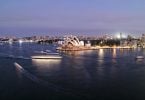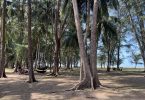As climate change thaws the North, Arctic cruises have proliferated. For the team of archeologists working feverishly over the next six weeks to discover John Franklin’s two lost ships, that rapid expansion of tourism is a blessing — but also occasionally a challenge.
Until recently, Canada’s Far North boasted ideal archeological conditions: frozen terrain that is little travelled. On both counts, the Arctic is changing.
Had the Arctic explorer been born in 1986 instead of 1786, John Franklin wouldn’t have had such a rough time navigating the Northwest Passage.
Today, for around $15,000 and two weeks of his time, he could have cruised in modern luxury through the polar passage he never officially found. True, he wouldn’t have become the protagonist in one of the world’s greatest naval mysteries. But he would have had an on-board massage therapist.
Tourist crossings of the Northwest Passage were once virtually impossible, owing to thick sea ice — the same ice that in September 1846 trapped Franklin’s two ships, HMS Erebus and HMS Terror, eventually forcing the crews to abandon both vessels and set off south on foot. No one survived.
But now Arctic sea ice is thinning and retreating due to climate change, and cruise ship traffic is picking up. According to one study, the number of Arctic cruise itineraries doubled between 2005 and 2013. Last year, there were 23 voyages planned by eight ships.
For those on the marine side of the search for the Erebus and the Terror, that growth has provided a helpful impetus.
This year’s four-vessel marine mission is equipped with multi-beam sonar, side-scan sonar, an autonomous and a remotely operated underwater vehicle and access to satellite imagery, with which they hope to map 1,400 square km of sea floor that may or may not contain the wreckage of two ships.
Either way, those high-definition maps will be shared with other agencies: the Canadian Hydrographic Service and the Canadian Coast Guard are two of the many partners in the mission.
There are “an increasing number of cargo ships and cruise ships with passengers supporting the local economy. But they can’t just go wherever they please. They have to have safely surveyed routes,” said Harris.
In 2010, the cruise ship Clipper Adventurer grounded on an underwater cliff in Coronation Gulf in western Nunavut. The Transportation Safety Board reported that none of the 128 evacuated passengers were injured and little pollution resulted, but the incident underscored the hazards of navigating Arctic waters.
On the terrestrial side of the search, tourism has also been a boost, thought it has created tensions at times.
The land-based team, like the marine team, has a variety of goals for the 2014 mission. One of those is to map known Franklin archeological sites where human remains or artifacts have been found.
Nunavut has put in place a system whereby cruise ships that want to visit historic or archeological sites must apply for a permit. Sites like Beechey Island, where Erebus and Terror overwintered in 1845-1846 and where markers for Franklin graves still stand, are well established.
But the thawing sea ice means tourists can now access once-hard-to-reach historic sites like King William Island, where the Franklin crew met disaster after abandoning both ships.
Uncontrolled access to archeological or paleontological sites can be damaging. In the 1980s, scientists on Nunavut’s Axel Heiberg Island discovered a 40-million-year-old “fossil forest” of mummified — rather than petrified — trees, an incredible glimpse into life in an era when the poles were much warmer. The University of Saskatchewan’s Jim Basinger was one of the scientists who studied the site.
The systems now in place are meant to prevent these problems, and experts, including Stenton and Grenier, stress that the cruise ship industry is largely very responsible. Many ships hire professional anthropologists and archeologists as tour guides, who understand best practices for visiting sensitive sites.
But the Arctic is vast and hard to monitor, and smaller private yachts are also now plying the Northwest Passage.
Archeologists are not the only ones with concerns. Environmental scientists say the increased vessel traffic brings increased potential for disturbing animal habitats — or worse, a major wreck, which could dump huge amounts of fuel into a fragile and already stressed environment.
Yet very few people want to see Arctic cruise traffic cut off.
(eTN): John Franklin: Tourism may finally find his two lost ships | re-post license | post content






















